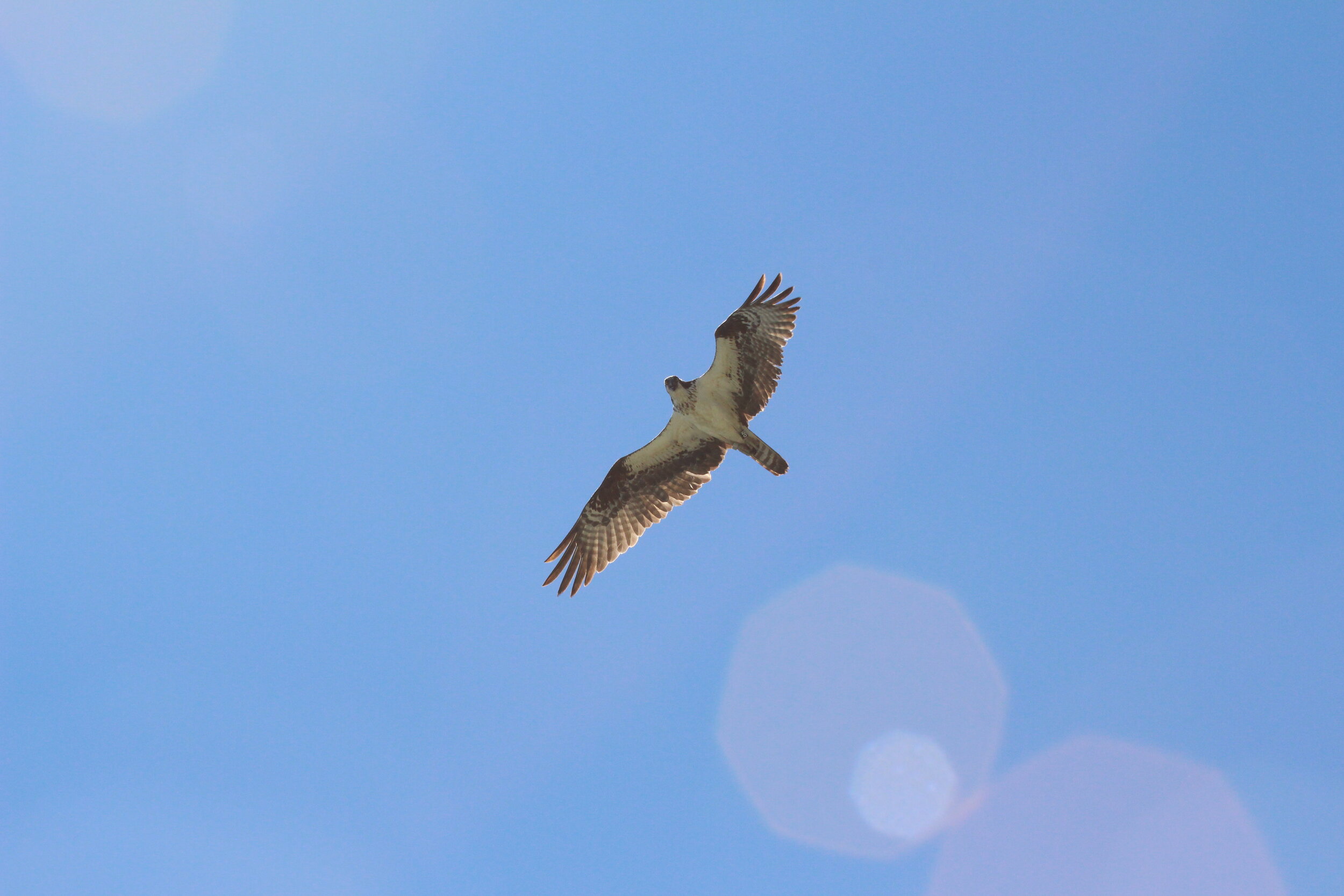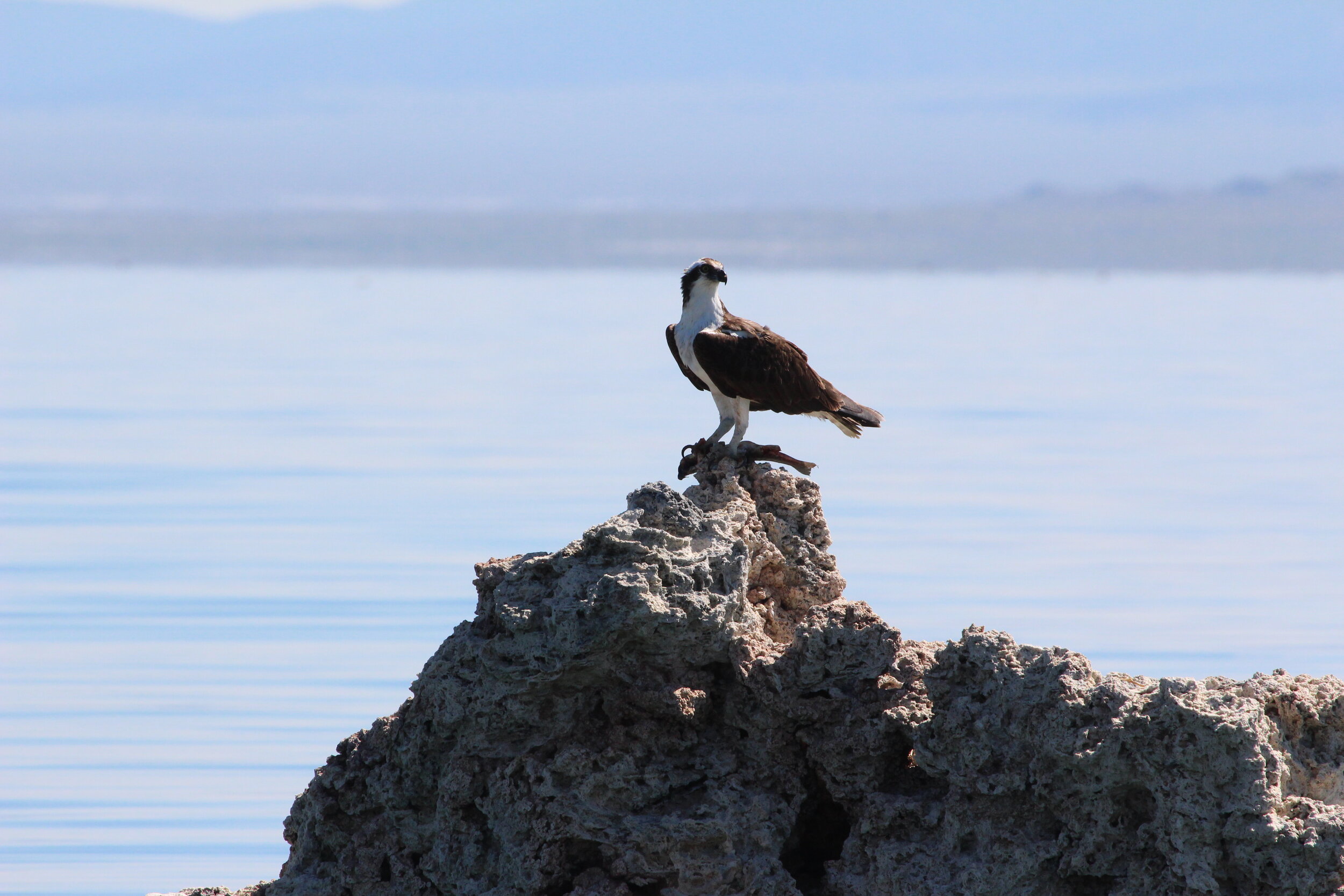As we approach the end of this challenging year, we would like to share with you a little known but wonderfully significant conservation story that takes place every year at Mono Lake, California. This ancient saline soda lake has proven to be an important (albeit improbable) ecological setting for the recovery tale of a unique raptor – the Osprey.
What makes Mono Lake so special? The lake was formed around one million years ago, in a high desert basin located in the Eastern Sierra mountain range. The body of water that is visible now is technically the saline leftovers of a Pleistocene-era freshwater lake. Mono Lake is known as an endorheic (terminal) lake; unlike most other lakes, it does not drain to the ocean via rivers, streams, or through underground diffusions of permeable rocks. Mono Lake receives it water from rainfall, as well as tributary streams which transport many minerals and erosion material from the nearby mountains that, without an outlet, ultimately build-up in the lake, increasing its salinity and alkalinity. Most organisms cannot survive in these inhospitable waters, especially not fish. But a special species of brine shrimp (Artemia monica), found nowhere else in the world, live here, along with alkali flies. During the autumn season, trillions of these creatures attract millions of migrating shorebirds, some of which get so fat they cannot fly for several days after feasting. The lake is part of the Long Valley volcanic caldera, and the two islands in the middle of the lake were formed during the last eruptions between 2000 years ago to as recently as 300 years ago. There are also the world-famous unusual rock formations known as “tufa” along the shores of Mono Lake. These calcium carbonate rock spires are formed when local calcium-rich freshwater springs feed into and mix with the carbonate-heavy lake water, causing a chemical reaction that over time (decades to centuries), results in the tufa towers. No trees can grow near the shores of Mono Lake, making the tufa stand out spectacularly in this high desert environment.
So where does the fish-eating Osprey fit into all of this?
In California, Osprey were historically found mostly along the Pacific coastline, and only ventured inland to major freshwater lakes such as the central valley Clear Lake, or the northeastern Eagle Lake. Osprey populations in California had been declining since the early 1900’s, mostly due to indiscriminate shooting and then, after WWII, suffered further losses due to pesticide pollution (DDT). DDT was banned in 1972, and in the 1980’s, breeding pairs of Osprey were found to be colonizing the Lake Tahoe basin to the east of the Sierra Nevada range. Then in 1985, there was an observation of an Osprey nest on top of a tufa tower at Mono Lake. Other pairs began colonizing this fish-less lake too, and finally a successful fledging of nestlings was documented in 1989. California State Parks staff began monitoring the Osprey nests in 2004, in order to document the occupancy, productivity and habitat use of Ospreys at Mono Lake.
Since Osprey feed primarily on fish, the unusual ecological situation at Mono Lake seems completely unsuitable for raising chicks. But nesting on tufa towers surrounded by hypersaline and hyperalkaline water gives them a distinct advantage – low predation rate of eggs and chicks by land animals (i.e. raccoons, skunks, foxes, snakes, etc.). Osprey chicks are also normally predated upon by aerial predators like owls and eagles, but for reasons not well-studied, it is much less likely for those large raptors to be a nuisance at the Mono Lake Osprey nests. And while Mono Lake itself cannot support a supply of fish, nearby streams and smaller lakes are stocked with fish by the California Department of Fish & Wildlife, to supplement the local populations that are fished for sport and consumption by humans. During the first nine years of monitoring by CA State Parks staff, no correlation was found between the success of a tufa nest and its distance to fishable waters. Some Osprey would regularly fly over 6 km to hunt for fish to bring back to the nest, and some would fly even greater distances if needed to feed their young. There are trees along the shorelines of these fishable waters that would be just as suitable for an Osprey nest, but clearly the lack of predators at Mono Lake provides a much needed advantage that makes the long-distance hunts worthwhile.
About 12 years ago, Bloom Biological’s founder and raptor ecologist Dr. Peter Bloom was invited by California State Parks’ Environmental Scientist Lisa Fields to join in the Osprey nest monitoring at Mono Lake – with close to 50 years of raptor conservation work, Pete has been able to add valuable insights to the monitoring efforts, and the team began banding all the nestlings they could in order to track their movements. Observations of some banded Ospreys from Mono Lake have been remarkable; for example, a banded Mono Lake Osprey was found in Alabama in 2016, and in recent years a few have been reported in Texas, including a chick banded earlier this summer. The work still continues, now with wildlife biologist Ashli Lewis at the helm of their rickety donated boat from the 1990’s. It is hard to describe what actually goes into the annual banding efforts, but a wonderful and enlightening video was created this year by Sarinah Simons of CA State Parks, which shows just how amazingly dedicated and hardworking both Ashli and Pete, along with other members of the monitoring teams, are. And of course who can resist watching the adorably funny-looking Osprey chicks get their shiny new bracelets!
As with every conservation story, there have been many ups and downs. There have been issues with falling water levels at Mono Lake, due to inflow water sources being diverted to drinking water pipelines destined for southern California. Another potential issue is pollution – one of the main causes of early Osprey decline in California was due to environmental contamination, especially pesticides. Endorheic lakes can be more susceptible to environmental pollutants because there is no natural filter or outflow of water, so it is important to ensure the inflow of water to Mono Lake remains uncontaminated, not just for the Osprey but for the millions of other birds who rely on it as a stopover during migration. There are plans being made between Pete and CA State Parks to begin monitoring a Black-crowned Night Heron nesting colony at Mono Lake, including banding and tracking chicks born in the shrub nests on one of Mono Lake’s islands.
This year brought even more challenges with the ongoing pandemic, reducing travel and therefore decreasing income for the CA State Parks. Funding for this project has always been very low, with Pete often donating his time and materials. But with Covid-19, funding for things like fixing their boat this year was nonexistent, and CA State Parks employees have all heroically taken a 10% paycut. Unfortunately, we have learned that there will be no funding for banding Osprey chicks at Mono Lake during the 2021 nesting season. We know that many people are struggling financially right now, but if you would like to donate to our non-profit Bloom Research Inc., please go to the website and click on the donate button (www.bloomresearch.org). Funds donated to BRI are tax deductible and are used to cover the costs of banding projects throughout California, such as the Ospreys and hopefully Black-crowned Night Herons at Mono Lake.
We hope you enjoyed the video – please let California State Parks Sierra District know how much you appreciate their dedication to the conservation of habitat and iconic species such as the Osprey by liking the video, and check out the other great conservation stories on their channel. And please feel free to share both this post and the video!
2021 UPDATE: WE HAVE RECEIVED FUNDING, AND OSPREY CHICKS WILL AGAIN BE BANDED AT MONO LAKE! Special thanks to everyone who donated through the Bloom Research website, and we are also very grateful to The Bodie Foundation who has graciously covered the costs of the color bands for the Black Crowned Night Heron nesting colony!
Written by: Nicollet Overby
Photos by Pete Bloom and CA State Parks
For more information on Mono Lake and the surrounding environment, please check out these online resources:
https://www.parks.ca.gov/?page_id=514
https://www.usgs.gov/volcanoes/long-valley-caldera/long-valley-caldera-field-guide-mono-lake
https://www.visitcalifornia.com/experience/mono-lake-tufa-state-natural-reserve/
https://www.worldatlas.com/articles/fluvial-landforms-what-is-an-endorheic-basin.html
https://monolakecommittee.org/about/ecoflies
https://www.latimes.com/archives/la-xpm-2004-oct-12-os-field12-story.html
If you would like to read the official 2016 report published in the Journal of Raptor Research, “Osprey Occupancy of Mono Lake – Unique Habitat in Eastern California” by Lisa Fields and Joel Pagel, you can access it here:









